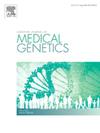色盲和MMAT综合征在一个家系中的并发遗传:遗传和临床见解。
IF 1.7
4区 医学
Q3 GENETICS & HEREDITY
引用次数: 0
摘要
背景:色盲是一种罕见的视网膜营养不良类型,表现为视力下降、钟摆性眼球震颤、畏光、辨色障碍和中央暗斑。在本研究中,我们调查了一个先证者及其家庭的色盲。方法:全外显子组测序鉴定了PDE6H和ADAMTS18的两个新变体。Sanger测序证实了变异的存在,并进一步用于确定其他家庭成员的合子状态。最后,对患者的临床表现进行全面评估。结果:我们在来自一个家系的6名患者中发现了两个基因的两个新变体:PDE6H (NM_006205.3):c。35C>G (p.SER12TER)和ADAMTS18 (NM_199355.4):c。3139 c > T (p.ARG1047TER)。先证者和他的两个姐妹在PDE6H变异上是纯合的,而在另一个变异上是杂合的。兄弟姐妹抱怨视力下降,辨色障碍,畏光和近视。椭球带破裂和钟摆性眼球震颤也分别出现在2例和3例患者中。两名患者在PDE6H中鉴定的变异为杂合的,在ADAMTS18中检测到的变异为纯合的。这两个人是这个家族的第二代,父母没有血缘关系。两者均表现为小角膜、近视眼和远眦。准时闭锁和斜视也被注意到。结论:PDE6H和ADAMTS18致病性变异可引起广泛的眼部疾病。我们建议,由于发展中国家的环境差异以及护理人员在面对这些疾病时所面临的问题,应优先考虑对罕见先天性遗传病的研究。本文章由计算机程序翻译,如有差异,请以英文原文为准。
Concurrent inheritance of achromatopsia and MMAT syndrome in a pedigree: Genetic and clinical insights
Background
Achromatopsia is a rare type of retinal dystrophy presenting with decreased visual acuity, pendular nystagmus, photophobia, impaired color discrimination, and central scotoma. In this study, we investigated achromatopsia in a proband and his family.
Methods
Whole-exome sequencing identified two novel variants in PDE6H and ADAMTS18. The presence of the variants was confirmed by Sanger sequencing and it was further utilized to determine the zygosity status of other family members. Lastly, the clinical presentations of the patients were thoroughly assessed.
Results
We identified two novel variants in two genes among six patients from a pedigree: PDE6H (NM_006205.3):c.35C > G (p.SER12TER) and ADAMTS18 (NM_199355.4):c.3139C > T (p.ARG1047TER). The proband and two of his sisters were homozygous for the variant in PDE6H and heterozygous for the other one. The siblings complained of decreased visual acuity, impaired color discrimination, photophobia, and myopia. Ellipsoid zone disruption and pendular nystagmus were also noted in two and three of the patients, respectively. Two affected patients were heterozygous for the variant identified in PDE6H and homozygous for the variant detected in ADAMTS18. These two are the second generation of the family, born to non-consanguineous parents. Both presented with microcornea, myopia, and telecanthus. Punctual atresia and strabismus were also noted.
Conclusion
Pathogenic variants in PDE6H and ADAMTS18 can cause a broad range of ophthalmic disorders. We suggest that the study of rare congenital genetic diseases in developing countries should be prioritized due to the differences in their environments and the issues care givers are confronted with when trying to face them.
求助全文
通过发布文献求助,成功后即可免费获取论文全文。
去求助
来源期刊
CiteScore
4.10
自引率
0.00%
发文量
193
审稿时长
66 days
期刊介绍:
The European Journal of Medical Genetics (EJMG) is a peer-reviewed journal that publishes articles in English on various aspects of human and medical genetics and of the genetics of experimental models.
Original clinical and experimental research articles, short clinical reports, review articles and letters to the editor are welcome on topics such as :
• Dysmorphology and syndrome delineation
• Molecular genetics and molecular cytogenetics of inherited disorders
• Clinical applications of genomics and nextgen sequencing technologies
• Syndromal cancer genetics
• Behavioral genetics
• Community genetics
• Fetal pathology and prenatal diagnosis
• Genetic counseling.

 求助内容:
求助内容: 应助结果提醒方式:
应助结果提醒方式:


